|
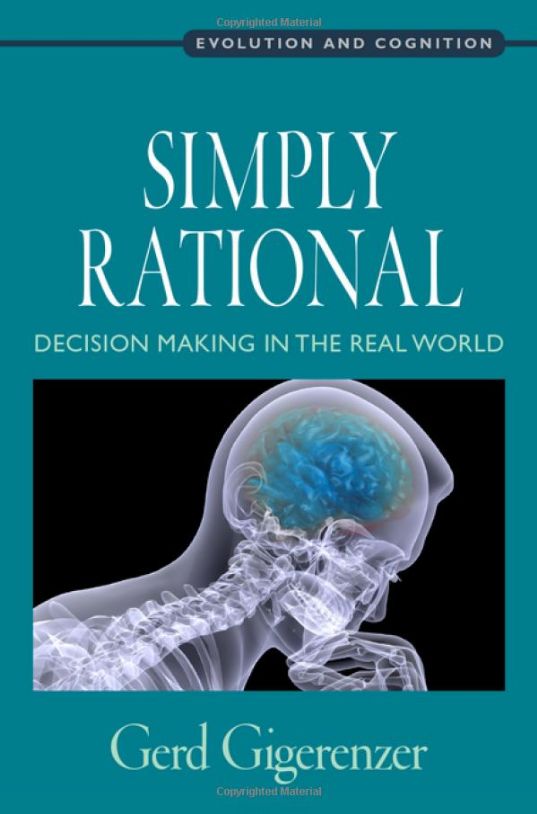 Simply
Rational: Decision Making in the Real World (2015) Simply
Rational: Decision Making in the Real World (2015)
Product Description: Statistical illiteracy can have an enormously
negative impact on decision making. This volume of collected papers
brings together applied and theoretical research on risks and decision
making across the fields of medicine, psychology, and economics.
Collectively, the essays demonstrate why the frame in which statistics
are communicated is essential for broader understanding and sound
decision making, and that understanding risks and uncertainty has
wide-reaching implications for daily life. Gerd Gigerenzer provides a
lucid review and catalog of concrete instances of heuristics, or rules
of thumb, that people and animals rely on to make decisions.
Table of Contents: 1) How I Got Started Teaching Physicians and
Judges Risk Literacy Part I: The Art of Risk Communication. 2) Why Do
Single-Even Probabilities Confuse Patients? 3) HIV Screening: Helping
Clinicians Make Sense of Test Results to Patients. 4) Breast Cancer
Screening Phamplets Mislead Women. Part
II. Health Statistics 5) Helping Doctors and Patients Make Sense of
Health Statistics. 6) Public Knowledge of Benefits of Breast and
Prostate cancer Screening in Europe. Part III.
Smart Heuristics. 7) Heuristic Decision Making. 8) The Recognition
Heuristic: A Decade of Research. Part IV:
Intuitions about Sports and Gender. 9) The Hot Hand Exists in Volleyball
is Is Used for Allocation Decisions. 10) Stereotypes about Men's and
Women's Intuitions: A Study of Two Nations. Part V. Theory. 11) As-if
Behavioral Economics: Neoclassical Economics in Disguise? 12) Personal
Reflections on Theory and Psychology.
Excerpts: Few pupils learn to see a connection between
statistics in school and what is going on in their world. Why do schools
contribute so little to statistical literacy? We believe their are four
factors. Statistical thinking is taught (a) too late in school, (b) with
representations that confuse young minds, (c) with boring examples that
kill motivation and (d) by teachers who are unversed in statistical
thinking. Statistical literacy should be taught as early as reading and
writing. An essential requirement for starting early is a discrete (not
continuous) concept of probability. Children can easily understand
natural numbers, whereas proportions and continuous quantities are more
difficult (Butterworth, 1999; Gelman & Gallistel, 1978). Yet many
mathematics educators insist that probability needs to be introduced as
a continuous variable along with continuous distributions. This
theoretical vision is a major obstacle to a successful head start with
statistical thinking.
For instance, at a conference on teaching statistics in school, where
we showed that children can easily understand statistics with discrete
representations (such as the absolute number of cases, as in Figs. 5.3
and 5.8), a mathematics professor asked why the frequentistic, discrete
concept of probability was being emphasized, as opposed to the
subjective, continuous concept (according to which a continuous
probability distribution describes a person's degree of belief in a
proposition, such as that the next president of the United States will
be Republican; see Savage, 1972). He seems to have been thinking about
philosophical schools of probability, not about children. <snip>
Statistical literacy is more than learning the laws of statistics; it is
about representations that the human mind can understand and remember.
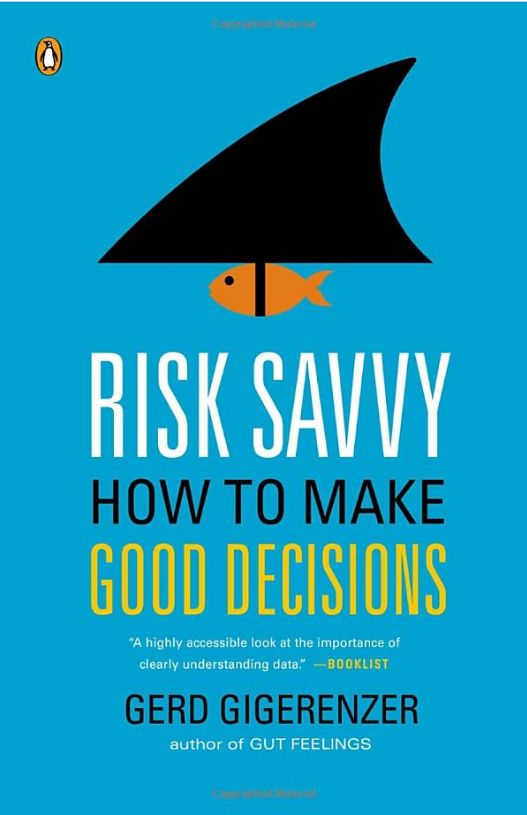 Risk
Savvy: How to Make Good Decisions (2015) Risk
Savvy: How to Make Good Decisions (2015)
Table of Contents: Part I: The Psychology of Risk. 1) Are People
Stupid? 2) Certainty is an Illusion. 3) Defensive Decision Making. 4)
Why Do We Fear What is Unlikely to Kill Us? Part II: Getting Risk
Savvy. 5) Mind Your Money. 6) Leadership and Intuition. 7) Fun and
Games. 8) Getting to the Heart of Romance. 9) What Doctors Need to Know.
10) Health Care: No Decision About Me Without Me. 11) Banks, Cows and
Other Dangerous Things. Part III. Start Early. 12) Revolutionize
School.
Numbers may not lie, but they are certainly often misunderstood,
according to German psychologist and risk analyst Gigerenzer. We make
poor decisions on an array of issues, from health-care screenings to
investment decisions to planned outings, because we blindly rely on data
that may be incorrectly interpreted and reported. Gigerenzer draws on
psychology, sociology, and math to explain how data can start off clear
and end up murky by the time it reaches its intended audience, leaving
us helpless to make sound decisions about the risks involved. He notes
that the risk of cancer is often misinterpreted and can lead to
overzealous screenings and that Americans irrationally refused to fly
after the 9/11 terrorist attacks even though the risk of being killed in
an auto accident is much greater. Gigerenzer cautions readers to always
look for a reference point when data is quoted and to understand the
difference between relative and absolute risk. This is a highly
accessible look at the importance of data and the equally great
importance of clearly understanding data. --Vanessa Bush
 Rationality
for Mortals: How People Cope with Uncertainty (Evolution and Cognition)
(5.2008) Rationality
for Mortals: How People Cope with Uncertainty (Evolution and Cognition)
(5.2008)
Product Description: Gerd Gigerenzer's influential work examines the
rationality of individuals not from the perspective of logic or
probability, but from the point of view of adaptation to the real world
of human behavior and interaction with the environment. Seen from this
perspective, human behavior is more rational than it might otherwise
appear. This work is extremely influential and has spawned an entire
research program. This volume (which follows on a previous collection,
Adaptive Thinking, also published by OUP) collects his most recent
articles, looking at how people use "fast and frugal heuristics" to
calculate probability and risk and make decisions. It includes a newly
written, substantial introduction, and the articles have been revised
and updated where appropriate. This volume should appeal, like the
earlier volumes, to a broad mixture of cognitive psychologists,
philosophers, economists, and others who study decision making.
 Gut Feelings: The Intelligence of the Unconscious Gut Feelings: The Intelligence of the Unconscious
by
Gerd Gigerenzer (2007, 288 pgs, hc $52).
Gut Feelings: The Intelligence of the Unconscious is "a fascinating analysis of how human beings make choices and
judgments based on instincts. Explains where gut feelings come
from and the role they play in our decisions ... from business
investments to choosing a mate. plenty of anecdotes that keep it
interesting and relevant."
is "a fascinating analysis of how human beings make choices and
judgments based on instincts. Explains where gut feelings come
from and the role they play in our decisions ... from business
investments to choosing a mate. plenty of anecdotes that keep it
interesting and relevant."
Editorial Reviews From
Publishers Weekly: Gigerenzer's theories about
the usefulness of mental shortcuts were a small but crucial element of
Malcolm Gladwell's bestseller Blink, and that attention has provided the
psychologist, who is the director of the Max Planck Institute for Human
Development in Berlin, the opportunity to recast his academic research
for a general audience. The key concept—rules of thumb serve us as
effectively as complex analytic processes, if not more so—is simple to
grasp. Gigerenzer draws on his own research as well as that of other
psychologists to show how even experts rely on intuition to shape their
judgment, going so far as to ignore available data in order to make snap
decisions. Sometimes, the solution to a complex problem can be boiled
down to one easily recognized factor, he says, and the author uses case
studies to show that the Take the Best approach often works. Gladwell
has in turn influenced Gigerenzer's approach, including the use of
catchy phrases like the zero-choice dinner and the fast and frugal tree,
and though this isn't quite as snappy as Blink, well, what is? Closing
chapters on moral intuition and social instincts stretch the central
argument a bit thin, but like the rest will be easily absorbed by
readers. Illus. (July 9)
Heuristics and the Law
(2006)
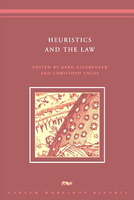 Review:
"An excellent collection, and an important contribution to exciting
new work at the intersection of psychology, economics, and law. Highly
recommended for everyone interested in knowing how people really
behave--and in understanding how actual behavior affects the law."
-- Cass R. Sunstein, Law School and Department of Political
Science, University of Chicago Review:
"An excellent collection, and an important contribution to exciting
new work at the intersection of psychology, economics, and law. Highly
recommended for everyone interested in knowing how people really
behave--and in understanding how actual behavior affects the law."
-- Cass R. Sunstein, Law School and Department of Political
Science, University of Chicago
"For legal academics and policy makers who think that the use of
heuristics leads to suboptimal decision making and the possibility of
exploitation, this book opens a window onto a more charitable view of
heuristics: that they are fast and frugal decision-making techniques
that may outperform statistical methods that purport to evaluate a
fuller set of informational cues. It provides not just a conceptual
overview of alternative understandings of heuristics but a number of
interesting hypotheses about jurisprudence, rules of evidence and jury
behavior, and barriers to implementation of formal legal commands."
-- Mark Kelman, William Nelson Cromwell Professor of Law and Vice Dean,
Stanford Law School
Book Description: In recent decades, the economists' concept of
rational choice has dominated legal reasoning. And yet, in practical
terms, neither the lawbreakers the law addresses nor officers of the law
behave as the hyperrational beings postulated by rational choice.
Critics of rational choice and believers in "fast and frugal heuristics"
propose another approach: using certain formulations or general
principles (heuristics) to help navigate in an environment that is not a
well-ordered setting with an occasional disturbance, as described in the
language of rational choice, but instead is fundamentally uncertain or
characterized by an unmanageable degree of complexity. This is the
intuition behind behavioral law and economics. In Heuristics and the
Law, experts in law, psychology, and economics explore the
conceptual and practical power of the heuristics approach in law. They
discuss legal theory; modeling and predicting the problems the law
purports to solve; the process of making law, in the legislature or in
the courtroom; the application of existing law in the courts,
particularly regarding the law of evidence; and implementation of the
law and the impact of law on behavior.
Contributors: Ronald J. Allen, Hal R. Arkes, Peter Ayton, Susanne
Baer, Martin Beckenkamp, Robert Cooter, Leda Cosmides, Mandeep K. Dhami,
Robert C. Ellickson, Christoph Engel, Richard A. Epstein, Wolfgang
Fikentscher, Axel Flessner, Robert H. Frank, Bruno S. Frey, Gerd
Gigerenzer, Paul W. Glimcher, Daniel G. Goldstein, Chris Guthrie,
Jonathan Haidt, Reid Hastie, Ralph Hertwig, Eric J. Johnson, Jonathan J.
Koehler, Russell Korobkin, Stephanie Kurzenhäuser, Douglas A. Kysar,
Donald C. Langevoort, Richard Lempert, Stefan Magen, Callia Piperides,
Jeffrey J. Rachlinski, Clara Sattler de Sousa e Brito, Joachim Schulz,
Victoria A. Shaffer, Indra Spiecker genannt Döhmann, John Tooby, Gerhard
Wagner, Elke U. Weber, Bernd Wittenbrink
Reckoning with Risk: Learning to Live with Uncertainty
(2003)
 Product
Description: At the beginning of the 20th century, the father of
modern science fiction, H.G. Wells, predicted that statistical thinking
would be as necessary for citizenship in a technological world as the
ability to read and write. Yet, a century on, most of us, from
television weather forecasters to the American President, seem to have
no idea of how to reason about uncertainties. Accordingly, a number of
books have marshalled a long roster of cognitive illusions as evidence
of humans' fundamental irrationality. Detailing case histories and
examples, this text presents readers with tools for understanding
statistics. In so doing, it encourages us to overcome our innumeracy and
empowers us to take responsibility for our own choices. Product
Description: At the beginning of the 20th century, the father of
modern science fiction, H.G. Wells, predicted that statistical thinking
would be as necessary for citizenship in a technological world as the
ability to read and write. Yet, a century on, most of us, from
television weather forecasters to the American President, seem to have
no idea of how to reason about uncertainties. Accordingly, a number of
books have marshalled a long roster of cognitive illusions as evidence
of humans' fundamental irrationality. Detailing case histories and
examples, this text presents readers with tools for understanding
statistics. In so doing, it encourages us to overcome our innumeracy and
empowers us to take responsibility for our own choices.
Review: "This is an important book, full of relevant examples and
worrying case histories. By the end of it, the reader has been presented
with a powerful set of tools for understanding statistics...anyone who
wants to take responsibly for their own medical choices should read it"
- New Scientist
Review: Most adults consider themselves numerate if they can
perform the simple functions of addition, subtraction, multiplication
and division. An understanding of the way numbers work is increasingly
important as our lives become more and more informed by them; many of
the everyday decisions we have to make involve the understanding of
complex figures, the news we hear is backed up by statistics, we
routinely talk of percentages and ratios in the most casual
conversations. However, even those who think they're thoroughly au fait
with these techniques can easily be fooled by the misleading
presentation of figures, whether through deliberate misrepresentation by
cynical politicians or advertisers, or insufficient lucidity on the part
of news reporters, doctors, lawyers and other influential individuals.
In this book, Gerd Gigerenzer attempts to illuminate this widespread
misrepresentation and suggests clear paths of thought to be used when
faced with 'incontrovertible' facts derived from spurious mathematics.
Gigerenzer is not short of examples to illustrate his case. One, derived
from the work of mathematician John Allen Paulos, concerns a TV weather
forecaster reporting that there was a 50 percent chance of rain on a
Saturday and a 50 percent chance of rain on the Sunday, and concluding
that this meant that there was a 100 percent chance of rain that
weekend. This kind of functional innumeracy is found again and again,
from trivial examples such as the above to those involving crucially
important situations such as AIDS testing and mammogram results. This is
no mere whine about 'falling standards', but instead points up a general
lack of perception in a central area of our lives which materially
affects the way we make important decisions. And it's a good read as
well; the examples given are interesting stories in themselves and
Gigerenzer is a lively narrator who moves smoothly from one chapter to
another. Add to this a number of beguilingly simple methods towards
clearer thinking and some fascinating sidelines on the nature of
probability, and I reckon nine out of ten readers will say their cats
enjoyed this book. Probably. (Kirkus UK)
Adaptive Thinking
(2002)
 Reviews (Amazon.com): In Adaptive Thinking, Gerd
Gigerenzer follows up on his earlier book, The Empire of Chance.
Part of his new book, Adaptive Thinking, is a continuation of his
earlier discussion. Gigerenzer reacts against the dominance of
significance testing, and looks closely at how it has shaped
psychological theories. In particular, Gigerenzer places the "cognitive
illusions" of Tversky, Khanneman, and many other behavioral scientists
under very close scrutiny.
Reviews (Amazon.com): In Adaptive Thinking, Gerd
Gigerenzer follows up on his earlier book, The Empire of Chance.
Part of his new book, Adaptive Thinking, is a continuation of his
earlier discussion. Gigerenzer reacts against the dominance of
significance testing, and looks closely at how it has shaped
psychological theories. In particular, Gigerenzer places the "cognitive
illusions" of Tversky, Khanneman, and many other behavioral scientists
under very close scrutiny.
Gigerenzer's main thrust is
that humans did not evolve in the psychology laboratory, with good
command of probability theory to help them work on word problems.
Instead, he argues, humans evolved in environments with lots of noise,
and had to use regular features of the world to develop simple and
effective rules of action. In this, he echoes and extends the work by
economist Herbert Simon in the 1950s.
Take one of his examples:
You live in Detroit. 1 in 100 new cars of brand X break down. 10 in 100
cars of brand Y break down. Your friend has car X, and it just broke
down yesterday. Which should you buy? Well, clearly if you're "rational"
you buy brand X. But consider:
You live in a jungle. 1 in
100 children is eaten by a crocodile while swimming in the river. 10 in
100 falls to their death while playing in the tree. Just yesterday,
little Bobby was swimming and got eaten by a crocodile. Where should you
let your kid play?
According to Tversky,
Khanneman, and other modern cognitive scientists, you would be
"irrational" to fear the river, since the long term probability of dying
there is still only 2 out of 100.
If we evolved in the jungle
situation, is it any wonder that most people rely on the advice of their
friend in the car situation? Does this make them "irrational?"
Gigerenzer looks at the
history of decision research, and offers a concrete and predictive
program for the study of human rationality. The book is fairly short,
very interesting, and casts serious doubt on many aspects of
contemporary cognitive research. I recommend it to anyone with an
interest in psychology or decision making, even non professionals.
Reviewed in
Human Nature
Review, 2002 Volume 2: 548-550 ( 12 December ) by Lisa Bortolotti,
Philosophy Program, ANU, Canberra Australia.
Bounded Rationality: The Adaptive Toolbox (2001)
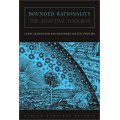 "Bounded
Rationality constitutes a milestone in the development of a framework
for understanding human cognition." -- Robert Kurzban, Contemporary
Psychology "Bounded
Rationality constitutes a milestone in the development of a framework
for understanding human cognition." -- Robert Kurzban, Contemporary
Psychology
Book Description
In a complex and uncertain world, humans and animals make decisions
under the constraints of limited knowledge, resources, and time. Yet
models of rational decision making in economics, cognitive science,
biology, and other fields largely ignore these real constraints and
instead assume agents with perfect information and unlimited time. About
forty years ago, Herbert Simon challenged this view with his notion of
"bounded rationality." Today, bounded rationality has become a
fashionable term used for disparate views of reasoning.
This book promotes bounded rationality as the key to understanding how
real people make decisions. Using the concept of an "adaptive toolbox,"
a repertoire of fast and frugal rules for decision making under
uncertainty, it attempts to impose more order and coherence on the idea
of bounded rationality. The contributors view bounded rationality
neither as optimization under constraints nor as the study of people?s
reasoning fallacies. The strategies in the adaptive toolbox dispense
with optimization and, for the most part, with calculations of
probabilities and utilities. The book extends the concept of bounded
rationality from cognitive tools to emotions; it analyzes social norms,
imitation, and other cultural tools as rational strategies; and it shows
how smart heuristics can exploit the structure of environments.
Simple Heuristics That Make Us Smart
(1999)
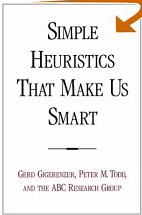 Review:
"In the past few years, the theory of rational (sensible) human behavior
has broken loose from the illusory and empirically unsupported notion
that deciding rationally means maximizing expected utility. Research has
learned to take seriously and study empirically how real human beings
... actually address the vast complexities of the world they inhabit.
Simple Heuristics ... offers a fascinating introduction to this
revolution in cognitive science, striking a great blow for sanity in the
approach to human rationality."--Herbert A. Simon, Carnegie Mellon
University, and Nobel Laureate in Economics Review:
"In the past few years, the theory of rational (sensible) human behavior
has broken loose from the illusory and empirically unsupported notion
that deciding rationally means maximizing expected utility. Research has
learned to take seriously and study empirically how real human beings
... actually address the vast complexities of the world they inhabit.
Simple Heuristics ... offers a fascinating introduction to this
revolution in cognitive science, striking a great blow for sanity in the
approach to human rationality."--Herbert A. Simon, Carnegie Mellon
University, and Nobel Laureate in Economics
TABLE OF CONTENTS
The ABC Research Group I.
The Research Agenda 1. Gerd Gigerenzer and Peter M. Todd: Fast and
Frugal Heuristics: The Adaptive Toolbox II. Ignorance-Based Decision
Making 2. Daniel G. Goldstein and Gerd Gigerenzer: The Recognition
Heuristic: How Ignorance Makes Us Smart 3. Bernhard Borges et al.: Can
Ignorance Beat the Stock Market? III. One-Reason Decision Making 4. Gerd
Gigerenzer and Daniel G. Goldstein: Betting on One Good Reason: The Take
The Best Heuristic 5. Jean Czerlinski, Gerd Gigerenzer, and Daniel G.
Goldstein: How Good Are Simple Heuristics? 6. Laura Martignon and Ulrich
Hoffrage: Why Does One-Reason Decision Making Work? A Case Study in
Ecological Rationality 7. Jorg Rieskamp and Ulrich Hoffrage: When Do
People Use Simple Heuristics, and How Can We Tell? 8. Laura Martignon
and Kathryn Blackmond Laskey: Bayesian Benchmarks for Fast and Frugal
Heuristics IV. Beyond Choice: Memory, Estimation, and Categorization 9.
Ulrich Hoffrage and Ralph Hertwig: Hindsight Bias: A Price Worth Paying
for Fast and Frugal Memory 10. Ralph Hertwig, Ulrich Hoffrage, and Laura
Martignon: Quick Estimation: Letting the Environment Do the Work 11.
Patricia M. Berretty, Peter M. Todd, and Laura Martignon: Categorization
by Elimination: Using Few Cues to Choose V. Social Intelligence 12.
Philip W. Blythe, Peter M. Todd, and Geoffrey F. Miller: How Motion
Reveals Intention: Categorizing Social Interactions 13. Peter M. Todd
and Geoffrey F. Miller: From Pride and Prejudice to Persuasion:
Satisficing in Mate Search 14. Jennifer Nerissa Davis and Peter M. Todd:
Parental Investment by Simple Decision Rules VI. A Look Around, A Look
Back, A Look Ahead 15. Adam S. Goodie et al.: Demons versus Heuristics
in Artificial Intelligence, Behavioral Ecology, and Economis 16. Peter
M. Todd and Gerd Gigerenzer: What We Have Learned (So Far) References
Name Index Subject Index
Reviews
(from Amazon website)
"How do people cope in the
real, complex world of confusing and overwhelming information and
rapidly approaching deadlines? This important book starts a new quest
for answers. Here, Gigerenzer, Todd, and their lively research group
show that simple heuristics are powerful tools that do surprisingly
well. The field of decision making will never be the same
again."--Donald A. Norman, author of Things That Make Us Smart and The
Invisible Computer
"Gigerenzer and Todd's
volume represents a major advance in our understanding of human
reasoning, with many genuinely new ideas on how people think and an
impressive body of data to back them up. Simple Heuristics is
indispensable for cognitive psychologists, economists, and anyone else
interested in reason and rationality."--Steven Pinker, author of How the
Mind Works and Words and Rules
"This book is a major
contribution to the theory of bounded rationality. It illustrates that
the surprising efficiency of fast and simple procedures is due to their
fit with the structure of the environment in which they are used. The
emphasis on this ecological rationality is an advance in a promising and
already fruitful new direction of research."--Reinhard Selten, Professor
of Economics at the University of Bonn, and Nobel Laureate in Economics
"In recent years, and
particularly in the culture wars, many people have written about
rationality. These authors now provide a summary of this recent history,
organized on the basis of different types of decision making. In each
case, the authors summarize the literature so as to provide an implicit
history. But the book is more fundamentally aimed at making rationality
workable by showing 'the way that real people make the majority of their
inferences and decisions.'"--Journal of the History of the Behavioral
Sciences
"The underlying argument of
the book is that the environments in which we evolved and in which we
now live have certain regularities, and that decision making mechanisms
- both evolved mechanisms, and the mechanisms that we actually use today
- take advantage of these environmental regularities. Most of the book
illustrates this argument by showing that in many circumstances shortcut
decision making mechanisms (the 'simple heuristics' of the title) are
remarkably accurate...This book by Gigerenzer and his associates marks a
significant advance in the analysis." -- Paul H. Rubin, Journal of
Bioeconomics, Vol 2, 2000
"The underlying argument of
the book is that the environments in which we evolved and in which we
now live have certain regularities, and that decision making
mechanisms--both evolved mechanisms, and the mechanisms that we actually
use today--take advantage of these environmental regularities. Most of
the book illustrates this argument by showing that in many circumstances
shortcut decision making mechanisms (the 'simple heuristics' of the
title) are remarkably accurate...This book by Gigerenzer and his
associates marks a significant advance in the analysis." -- Paul H.
Rubin, Journal of Bioeconomics, Vol 2, 2000
"Gigerenzer et al. take on
a heroic effort of creating a grand theory of mind ..."--Contemporary
Psychology, APA Review of Books
Calculated Risks: How to Know When Numbers Deceive You
(1986)
 Amazon.com:
In the tradition of
Innumeracy by John Allen Paulos, German scientist Gerd
Gigerenzer offers his own take on numerical illiteracy. "In Western
countries, most children learn to read and write, but even in adulthood,
many people do not know how to think with numbers," he writes. "I focus
on the most important form of innumeracy in everyday life, statistical
innumeracy--that is, the inability to reason about uncertainties and
risk." The author wisely uses concrete examples from the real world to
make his points, and he shows the devastating impact of this problem. In
one example, he describes a surgeon who advised many of his patients to
accept prophylactic mastectomies in order to dodge breast cancer. In a
two-year period, this doctor convinced 90 "high-risk" women without
cancer to sacrifice their breasts "in a heroic exchange for the
certainty of saving their lives and protecting their loved ones from
suffering and loss." But Gigerenzer shows that the vast majority of
these women (84 of them, to be exact) would not have developed breast
cancer at all. If the doctor or his patients had a better understanding
of probabilities, they might have chosen a different course. Fans of
Innumeracy will enjoy Calculated Risks, as will anyone who
appreciates a good puzzle over numbers. --John Miller --This
text refers to an out of print or unavailable edition of this title. Amazon.com:
In the tradition of
Innumeracy by John Allen Paulos, German scientist Gerd
Gigerenzer offers his own take on numerical illiteracy. "In Western
countries, most children learn to read and write, but even in adulthood,
many people do not know how to think with numbers," he writes. "I focus
on the most important form of innumeracy in everyday life, statistical
innumeracy--that is, the inability to reason about uncertainties and
risk." The author wisely uses concrete examples from the real world to
make his points, and he shows the devastating impact of this problem. In
one example, he describes a surgeon who advised many of his patients to
accept prophylactic mastectomies in order to dodge breast cancer. In a
two-year period, this doctor convinced 90 "high-risk" women without
cancer to sacrifice their breasts "in a heroic exchange for the
certainty of saving their lives and protecting their loved ones from
suffering and loss." But Gigerenzer shows that the vast majority of
these women (84 of them, to be exact) would not have developed breast
cancer at all. If the doctor or his patients had a better understanding
of probabilities, they might have chosen a different course. Fans of
Innumeracy will enjoy Calculated Risks, as will anyone who
appreciates a good puzzle over numbers. --John Miller --This
text refers to an out of print or unavailable edition of this title.
From Publishers Weekly
If a woman aged 40 to 50 has breast cancer, nine times out of 10 it will
show up on a mammogram. On the other hand, nine out of 10 suspicious
mammograms turn out not to be cancer. Confused? So are many people who
seek certainty through numbers, says Gigerenzer, a statistician and
behavioral scientist. His book is a successful attempt to help
innumerates (those who don't understand statistics), offering case
studies of people who desperately need to understand statistics,
including those working in AIDS counseling, DNA fingerprinting and
domestic violence cases. Gigerenzer deftly intersperses math lessons
explaining concepts like frequency and risk in layperson's terms with
real-life stories involving doctors and detectives. One of his main
themes is that even well-meaning, statistically astute professionals may
be unable to communicate concepts such as statistical risk to
innumerates. (He tells the true story of a psychiatrist who prescribes
Prozac to a patient and warns him about potential side effects, saying,
You have a 30 to 50 percent chance of developing a sexual problem. The
patient worries that in anywhere from 30% to 50% of all his sexual
encounters, he is going to have performance problems. But what the
doctor really meant is that for every 10 people who take Prozac, three
to five may experience sexual side effects, and many have no sexual side
effects at all.) All innumerates buyers, sellers, students, professors,
doctors, patients, lawyers and their clients, politicians, voters,
writers and readers have something to learn from Gigerenzer's quirky yet
understandable book.
Copyright 2002 Cahners Business Information, Inc. --This text refers
to an out of print or unavailable edition of this title.
Calculated risks: How to know when
numbers deceive you. New York: Simon & Schuster.
(UK version: Reckoning with risk: Learning to live with uncertainty,
London: Penguin).
The Empire of Chance (1989)
by
Gerd Gigerenzer, Zeno Swijtink, Theodore Porter, Lorraine
Daston, John Beatty, Lorenz Krüger
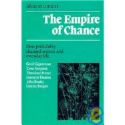 Review:
"...will be useful to statisticians, philosophers, scientists and other
historians of science who want to understand the roots of the
probability-based statistical methods we use so widely today...The
Empire of Chance is a valuable book." Science Review:
"...will be useful to statisticians, philosophers, scientists and other
historians of science who want to understand the roots of the
probability-based statistical methods we use so widely today...The
Empire of Chance is a valuable book." Science
"In contrast to the literature on the mathematical development of
probablilty and statistics, this book focuses on how technical
innovations remade our conceptions of nature, mind, and society. The
work is aimed at historians of science and philosophers of science, but
it is also directed toward scholars in other disciplines and therefore
technical material is kept to a minimum." Journal of the History of the
Behavioral Sciences
Book Description: This book tells how quantitative ideas of
chance have transformed the natural and social sciences as well as
everyday life over the past three centuries. A continuous narrative
connects the earliest application of probability and statistics in
gambling and insurance to the most recent forays into law, medicine,
polling, and baseball. Separate chapters explore the theoretical and
methodological impact on biology, physics, and psychology. In contrast
to the literature on the mathematical development of probability and
statistics, this book centers on how these technical innovations
recreated our conceptions of nature, mind, and society |



